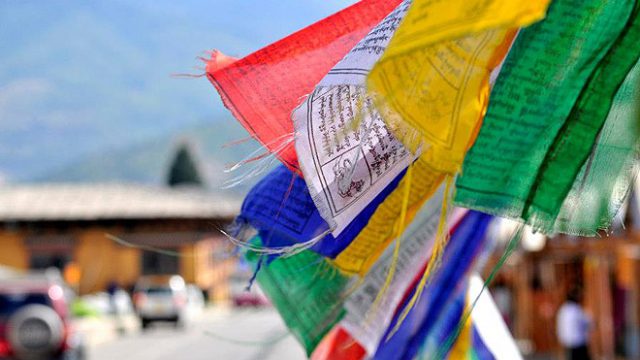Happy about the long weekend break this Holi? Why not use this time to explore the happiest country in Asia? Bhutan, nestled in the eastern Himalaya, is slowly becoming one of the hottest tourist destinations in the world. It’s ideal for Indian tourists, as there’s no need for a visa. If you have about five days, Paro and Thimphu are the best options. Bhutan can be reached both by air, as well as by road. Since it’s a long weekend, some of you might want to try the road, which is quite spectacular. Fly to Bagdogra in West Bengal and do the very scenic drive via Siliguri, Jaigaon and Phuentsoling to either Paro or Thimphu. A direct taxi to Thimphu or Paro costs approximately Rs 7,000-8,000 and takes about 13 hours. If that’s too much, then there are regular flights to Paro from Delhi, Kolkata, Guwahati and Mumbai. Here’s how you can do Bhutan (Thimphu and Paro) in five days and back.

THIMPHU
What To See & Do
If you are flying in directly to Paro, Thimphu is about a 90-minute drive away. Thimphu is the capital as well as the largest city and cultural hub. Start with the oldest monastic temple complex, the Changangkha Lhakhang. According to Bhutanese tradition, parents come here to get auspicious names and blessings for their newborns. From here, proceed to Dochu La—a picturesque pass dotted with prayer flags and a chorten (a stupa). It’s a great spot for a picnic with a grand view of the beautiful Himalaya.
Next place to visit is the Memorial Chorten, its golden spires and bells of which make it one of Bhutan’s most famous landmarks. A few kilometers away is famous monastery-cum-fortress Tashichho Dzong, originally constructed in the 13th century. Today it houses the throne room of the king of Bhutan as well as the administrative offices of the government.

On your second day of stay in Thimphu, you can take a break from visiting the dzongs (forts) and monasteries and explore the city’s other attractions like the weekend market, where you can shop for local handicrafts and other souvenirs. Another interesting place to visit is the Changlimithang Archery Ground. If you go early in the morning, you might even see archers practicing! You can end your Thimphu visit by visiting Buddha Point, from where you can get a lovely view of the Thimphu valley under the shadow of the 51-foot-high statue of the Buddha Dordenma, the largest in the country.
Where To Stay
Centrally located hotels like Hotel Norbuling (www.hotelnorbuling.com/bhutan-hotel; from Rs 4,900), Druk Hotel Thimphu (www.drukhotels.com/hoteldruk; from Rs 6,300), Taj Tashi Bhutan, Le Meridien Thimphu, Terma Linca Resort & Spa and Namgay Heritage Hotel, but the best options if you want to pamper yourself and enjoy the calm and quiet of Thimphu at the same time.
Where To Eat
Try the centrally located Musk Restaurant for a chance to interact with the locals. If you can’t leave your Indian taste-buds behind, then try Chula. For the best of local cuisine, try Bhutan Kitchen.

PARO
What To See & Do
Just an hour and a half away from Thimphu is Paro, a lovely city full of traditional architecture that’s best explored on foot. To begin with, visit the Drametse Lhakhang, a 16th century monastery of the Nyingma sect, set upon a narrow and steep, forested ridge. Home to some 80 monks, it’s famous for the Mask Dance of the Drums that takes place twice every year. Paro Dzong, also known as Rimpung Dzong, is another fine example of Bhutanese architecture. Open daily from 9am to 5pm, the Dzong offers a stunning view of the Paro valley. You’ll have to cross a unique covered bridge to enter the fort. Kyichu Lhakhang, a short drive away, dates back to the 7th century CE, when the Tibetan Emperor Songtsen Gampo was said to have established it. It is one of the most sacred shrines in Bhutan, and you shouldn’t miss the 7th century statue of the Sakyamuni Buddha, said to have been cast in Lhasa.

The iconic Taktsang Monastery or the Tiger’s Nest is best kept for towards the end of the trip, as it’s only fair to give your undivided attention to the most popular symbol of Bhutan. Within the country, it is probably the most sacred pilgrimage site, associated with the memory of Guru Padmasambhava, who’s said to have sanctified this cliff-top site in the 8th century CE. The hike up to the Tiger’s Nest takes around 3 hours, but worry not, there is a cafeteria on the way as well as an excellent spot from where you can get a great view of the monastery. There are timings for the monastery—October-March: 8am-1pm and 2pm to 5pm; April-September: 8am-1pm and 2pm-6pm. If you plan to do the trek, then start early because the cafeteria is open only from noon to 3pm.
Where To Stay
There are quite a few affordable and comfortable options in town, including Tiger’s Nest Resort (www.tigernest.bt; from Rs 3,450), Sonam Trophel Hotel (contact: +975 8 271 287) and Gangtey Palace Hotel. Since Paro is just an hour and a half away from Thimphu, you can easily stay at either Paro or Thimphu and explore these two valleys.
Where To Eat
Try the Taktsang Cafetaria while you’re hiking up to the Tiger’s Nest. For some great culinary experiences, try the Charro Restaurant, or the high-end Bukhari Restaurant.




